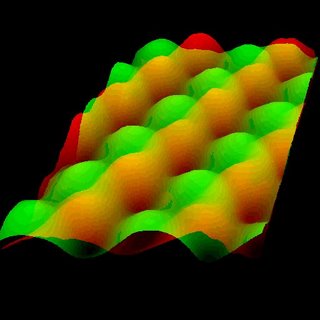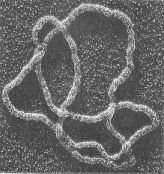Voluptuous Vistas
Sometimes it is difficult to figure out exactly what it is we see. Biologists would like very much to get a better view of complex molecules. How well can we see things at the atomic scale? Courtesy of Carnegie Mellon here is a picture  of a GaAs surface taken with a Scanning Tunnelling microscope. These microscopes use a needle probe with a single atom at its tip.
of a GaAs surface taken with a Scanning Tunnelling microscope. These microscopes use a needle probe with a single atom at its tip.
Atomic force microscopy has been used to do surface biology. It is a useful technique for looking at real-time processes involving DNA. Pictures of DNA look just like knotted circles, such as the picture shown.
But can we look closer at these molecules? And what do we really see on the largest scales? Make sure you take a look at the new graphs by the cosmologist Louise Riofrio.
 of a GaAs surface taken with a Scanning Tunnelling microscope. These microscopes use a needle probe with a single atom at its tip.
of a GaAs surface taken with a Scanning Tunnelling microscope. These microscopes use a needle probe with a single atom at its tip.Atomic force microscopy has been used to do surface biology. It is a useful technique for looking at real-time processes involving DNA. Pictures of DNA look just like knotted circles, such as the picture shown.

But can we look closer at these molecules? And what do we really see on the largest scales? Make sure you take a look at the new graphs by the cosmologist Louise Riofrio.







7 Comments:
09 05 06
Hello Kea:
Nice post you have here. I have been reading some of the papers you cite on your earlier posts, so thanks for the links! That DNA braid sure is cool! Braid theory and knot theory would be wonderous tools to describe these braided strands. I went to the mountains a coupla days ago and a man gave me a twig from a Juniper tree that is thousands of years old. Some of its needles were braided strands. Interesting how the lowest energy configuration for that needle system was a braid form! Cool! It is nice to see structures in nature that one studies in abstract fashion. Cool visuals:) BTW comment moderation? Trolls oh no!
09 05 06
Hello Kea:
Nice post you have here. I have been reading some of the papers you cite on your earlier posts, so thanks for the links! That DNA braid sure is cool! Braid theory and knot theory would be wonderous tools to describe these braided strands. I went to the mountains a coupla days ago and a man gave me a twig from a Juniper tree that is thousands of years old. Some of its needles were braided strands. Interesting how the lowest energy configuration for that needle system was a braid form! Cool! It is nice to see structures in nature that one studies in abstract fashion. Cool visuals:) BTW comment moderation? Trolls oh no!
09 05 06
Hello Kea:
Nice post you have here. I have been reading some of the papers you cite on your earlier posts, so thanks for the links! That DNA braid sure is cool! Braid theory and knot theory would be wonderous tools to describe these braided strands. I went to the mountains a coupla days ago and a man gave me a twig from a Juniper tree that is thousands of years old. Some of its needles were braided strands. Interesting how the lowest energy configuration for that needle system was a braid form! Cool! It is nice to see structures in nature that one studies in abstract fashion. Cool visuals:) BTW comment moderation? Trolls oh no!
09 05 06
Hello Kea:
Nice post you have here. I have been reading some of the papers you cite on your earlier posts, so thanks for the links! That DNA braid sure is cool! Braid theory and knot theory would be wonderous tools to describe these braided strands. I went to the mountains a coupla days ago and a man gave me a twig from a Juniper tree that is thousands of years old. Some of its needles were braided strands. Interesting how the lowest energy configuration for that needle system was a braid form! Cool! It is nice to see structures in nature that one studies in abstract fashion. Cool visuals:) BTW comment moderation? Trolls oh no!
09 06 06
Hello Kea:
I tried to leave a comment for you on my BSD box, but an issue with cookies disallowed me from doing so. I just wanted to say thanks for the links you have provided in your previous posts. I haven't commented because I need to get what you are talking about, and the links are helpful. In particular, I am sinking my teeth into the Polyhedra article by Satayan! Quite nifty!
Isn't that DNA braid wonderful? I smell some knot and braid theory arising as a descriptor of these biological phenomena hehehehheehe cool pictures as well!
09 06 06
OK Kea, I won't bother you again on this post but you have inspired me to pursue an avenue that I have been considering for a while! Check out this article to see what I mean:
Braiding DNA: Experiments,Simulations,and Models,(Charvin et al).
Without rambling too much when I next post I will certainly talk about braids. Besides that, when I was a kid they were everywhere in my neighborhood. Funny how it would be if all of the little Black ghetto kids who know how to cornrow hair knew the mathematical beauty behind their actions! But that is for another post on my blog:) Warmest Regards for a great rest of week:)
Hi Kea
Do you remember Wheeler's geons? I found this cool paper on the RP^3 geon:
Hawking radiation for Dirac spinors on the RP^3 geon
Projective space strikes yet again!
Post a Comment
<< Home